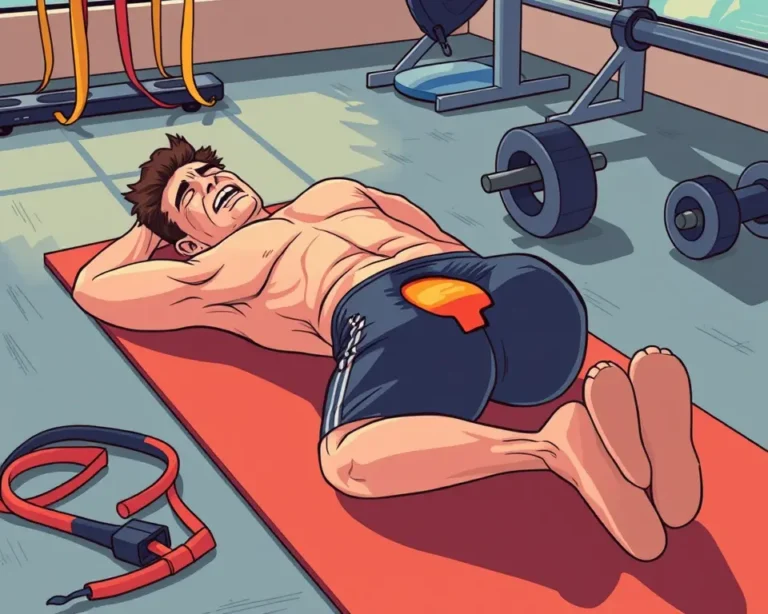A sacral stress fracture can be a painful setback, especially when it arises from a workout intended to improve fitness. These fractures, which are tiny cracks in the sacrum (the bone at the base of the spine), often occur due to repetitive stress and can sideline even the most dedicated fitness enthusiasts.
Understanding Sacral Stress Fractures
What is a Sacral Stress Fracture?
A sacral stress fracture is a small crack in the sacrum. Unlike acute fractures caused by a sudden impact, stress fractures develop gradually due to repetitive stress or overuse. In the context of exercise, this can happen when the sacrum is subjected to loads it isn’t prepared to handle. They are relatively uncommon but can occur due to repetitive stress rather than a single incident.
Causes and Risk Factors
Several factors can contribute to sacral stress fractures:
- High-impact activities: Distance running, especially with rapid increases in mileage, is a known risk factor.
- Inadequate strength training: Weak muscles around the pelvis and hips can lead to increased stress on the sacrum.
- Nutritional deficiencies: Insufficient calorie intake, low calcium levels, and vitamin D deficiency can weaken bones.
- Biomechanical issues: Subtle stiffness in the hip or leg-length discrepancies can cause abnormal loading of the sacrum.
- Osteoporosis and Osteopenia: These conditions weaken bones, making them more susceptible to stress fractures.
- Amenorrhea: The absence of menstruation, common in female athletes, can lead to decreased bone density.
Symptoms
Sacral stress fractures can be tricky to diagnose because the symptoms can mimic other conditions. Common symptoms include:
- Low back pain: Often described as a diffuse ache that worsens with activity and improves with rest.
- Buttock pain: Pain may radiate into the buttocks or even down the leg, sometimes mimicking sciatica.
- Sacroiliac joint pain: Tenderness over the sacrum and sacroiliac joint is common.
- Pain with weight-bearing: Walking or standing for extended periods can exacerbate the pain.
The Glute Bridge Connection
The glute bridge, a popular exercise for strengthening the glutes and hamstrings, involves lying on your back with your knees bent and lifting your hips off the floor. While generally safe and effective, improper form or excessive intensity can contribute to sacral stress fractures.
How Glute Bridges Can Cause Stress Fractures
- Hyperextension: Bridging too high can cause a spinal curve and turns the exercise into a back bridge. This shifts the focus from the glutes to the lower back, causing compression and pain.
- Overloading: Adding too much weight or resistance too soon can place excessive stress on the sacrum.
- Muscle Imbalances: If the glutes are weak, other muscles compensate, potentially leading to excessive stress on the sacrum.
- Poor Form: Incorrect technique can lead to undue stress on the lower back and sacrum.
Recovery and Rehabilitation
If you suspect you have a sacral stress fracture, seeking medical attention is crucial. Diagnosis typically involves imaging techniques like MRI. Treatment focuses on pain relief and promoting bone healing.
Initial Management
- Rest: The most important step is to avoid activities that cause pain. This may involve using crutches to minimize weight-bearing.
- Pain Relief: Over-the-counter pain relievers like NSAIDs or acetaminophen can help manage pain and inflammation.
- Ice: Applying ice to the affected area can reduce swelling and pain.
Rehabilitation Exercises
Once the initial pain subsides, a carefully designed rehabilitation program can help restore strength and function. The goal is to gradually increase activity levels while minimizing stress on the sacrum. A physical therapist can provide guidance and ensure proper form.
- Isometric Exercises: These involve contracting muscles without movement. Examples include buttock clenches performed lying, sitting, or standing.
- Core Strengthening: Activating the core muscles helps stabilize the spine and pelvis, reducing stress on the sacrum.
- Low-Impact Cross-Training: Activities like swimming, aqua jogging, or stationary biking can maintain cardiovascular fitness without stressing the sacrum.
- Glute Strengthening (Cautious Progression): As healing progresses, gentle glute exercises can be introduced, focusing on proper form and avoiding hyperextension. Examples include:
- Clamshells: Strengthen the gluteus medius while minimizing stress on the sacrum.
- Glute Bridges (Modified): Focus on a neutral spine and avoid lifting too high.
- Single-Leg Stands: Improve balance and stability.
- Fire Hydrants: Strengthen hip abductors, but avoid if they cause pain.
- Gait Training: Once weight-bearing is resumed, gait training helps restore a normal walking pattern and reduce stress on the sacrum.
Return to Activity
Returning to strenuous activity should be gradual and guided by a healthcare professional. A repeat MRI may be considered to ensure adequate healing.
- Gradual Progression: Increase activity levels slowly, monitoring for any pain or discomfort.
- Strength and Conditioning: Continue strengthening exercises to support the pelvis and hips.
- Proper Form: Maintain correct form during all exercises to minimize stress on the sacrum.
- Listen to Your Body: If you experience pain, stop the activity and rest.
Exercises to Avoid
During the recovery period, it’s important to avoid exercises that place excessive stress on the sacrum. These may include:
- High-impact activities: Running, jumping, and plyometrics should be avoided until the fracture is fully healed.
- Deep squats: These can place significant stress on the lower back and sacrum.
- Aggressive stretching: Avoid stretches that cause pain or discomfort in the sacrum.
- Loaded exercises: Exercises involving heavy weights, especially those that load the spine, should be avoided initially.
Safe Glute Exercises After Injury
Once you’re cleared to begin glute strengthening exercises, prioritize movements that minimize stress on the sacrum and focus on proper form.
- Clamshells: Lie on your side with your knees bent and feet together. Keeping your feet together, raise your top knee towards the ceiling.
- Glute Bridges (Modified): Lie on your back with your knees bent and feet flat on the floor. Engage your core and gently lift your hips off the floor, maintaining a neutral spine. Avoid arching your back.
- Bird Dog: Start on your hands and knees. Extend one arm forward and the opposite leg backward, keeping your core engaged and back flat.
- Buttock Clenches: Squeeze your buttock muscles together and hold for a few seconds.
- Standing Gluteus Medius Exercises: Abduction Lifts, Abduction Lifts with Internal Rotation and Fire Hydrants are all great ways to strengthen glutes.
Prevention Strategies
Preventing sacral stress fractures involves addressing risk factors and adopting safe training practices.
- Gradual Progression: Increase training intensity and volume gradually, avoiding sudden spikes.
- Strength Training: Incorporate regular strength training to support the muscles around the pelvis and hips.
- Proper Nutrition: Ensure adequate intake of calcium, vitamin D, and other essential nutrients.
- Good Form: Pay attention to proper form during all exercises, especially glute bridges and squats.
- Listen to Your Body: Don’t ignore pain. Rest and seek medical attention if you experience any discomfort.
- Cross-Training: Incorporate low-impact activities to reduce repetitive stress on the sacrum.
- Footwear and Orthotics: Wear supportive shoes and consider orthotics if you have flat feet or other biomechanical issues.
Conclusion
While exercises like glute bridges can be highly effective for building a bigger butt, it’s essential to approach them with caution and awareness. Understanding the risk factors for sacral stress fractures, using proper form, and listening to your body can help you achieve your fitness goals without injury. If you experience pain, don’t hesitate to seek medical advice and follow a carefully designed rehabilitation program to ensure a safe and full recovery.







